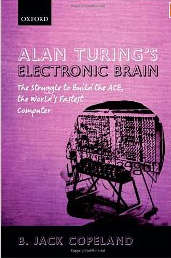| Alan Turing's Electronic Brain |
|
Author: B. Jack Copeland Alan Turing didn't have an electronic brain, but he did try to build one. This is a new paperback edition of a book that was first published in hardback 2005 as Alan Turing's Automatic Computing Engine: The Master Codebreaker's Struggle to Build the Modern Computer. As the title of the original version and the subtitle of the reprint - The Struggle to Build the ACE, the World's Fastest Computer - make clear, it is the ACE computer that is the main subject of this book and Alan Turing mostly takes a back seat to the technology.
The most important thing to say about this book is that it is not a light read. This is not a Turing biography, a docu-drama or a popularized account of his work or his life. It is a collection of fairly academic accounts, by Jack Copeland and many others including Turing himself, of things that happened connected to the building of the ACE - the computer that Turing had a big part in designing. Part I of the book is all about the project and how it was started at the UK's National Physical Laboratory (NPL). In fact the first two chapters are on how the NPL got started and why a mathematics division was created there. The other two papers in this section discuss the details of how the ACE project got off the ground at the NPL. A lot of this part of the book is about who did what at what meeting and how Turing got involved. If your main interest is in the technology or the theory that Turing used to implement a computer, then this first part of the book will be of little interest to you.
The second part of the book - curiously titled Turing and the History of Computing - is much more about the technology and the ideas. The first paper -Turing and the computer - goes into a lot of detail about how Turing thought about computers and the influence that the idea of Turing machine had on other people. Today we tend to think of a Turing machine as a theoretical device but back then it was what gave von Neumann the certainty that a stored program computer could be a universal computing machine. The later part of the paper explains how Turing thought about logic and how he might have invented the neural network if only he had had a working computer. He seems to have been the first to start to think about logic nets and the ideas of connectionism and even invented some simple learning rules well before Hebb got in on the act. The reason we don't know all of this is put down to Turing's reluctance to publish things. By the time that a computer was available to him, he had moved on to his studies of morphogenisis and neural networks were forgotten. What is interesting is that Turing's diagrams of the logic of ACE look more like McCullloch-Pitts neural networks than the sort of logic diagrams we are familiar with. The remaining papers in this part are less interesting if you are interested in Turing and his ideas. These include papers on the way the ACE influenced British computing and at the architecture of the ACE machines. Part III focuses on the architecture of the ACE and includes a look at its instruction set and how to program it. There is a paper on the DEUCE - the commercial machine derived from the ACE. A particularly interesting paper describes the ACE Simulator and the Cybernetic model - both relay computers designed by Michael Woodger (the author of the paper) to test Turing's ideas. The cybernetic model was a simple learning machine and it was even demonstrated on television. Part IV of the book is on electronics - not something you would think was needed, but how many today have any idea how valves or vacuum tubes work. There are papers that describe the basic operation of a triode and simple logic circuits using valves. The final part is a collection of original technical reports and lectures on the ACE 1945-47. Three of them were written by Turing himself and the final one is a seminal paper by Harry D. Huskey comparing the state of the art of computing in the US and the UK when he visited NPL, Cambridge and Manchester in 1947. Overall this book is a very mixed bag of papers on the ACE and ideas that Turing had around the time he was working on the ACE. Its biggest problem is that it isn't coherent in any sense of the word and it mostly lacks analysis. It is almost a collection of source material that could be used to write a more ordered account of what went on at the time. Personally I found the accounts of the design and implementation of the ACE most interesting and the few bits of information on Turing's ideas on learning machines and neural networks fascinating. I was less interested in the detailed who-did-what accounts of the goings on at the NPL, but this is a matter of taste. This is not a book for the casual reader, but if you are interested in the history of computing and find the whole Turing story interesting, this represents an easy to use source of information. Related Articles
|
|||
| Last Updated ( Saturday, 17 November 2012 ) |

